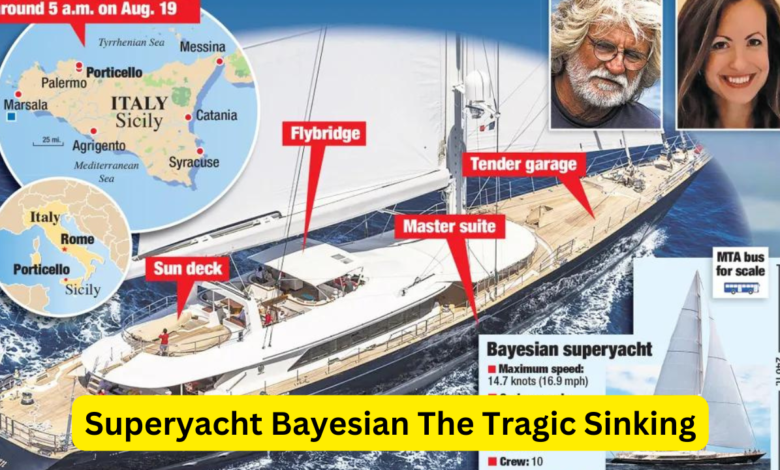Superyacht Bayesian

The recent sinking of Mike Lynch’s opulent superyacht, the Superyacht Bayesian, has stirred intense media coverage and public scrutiny. This tragic event, which took place off the coast of Sicily, not only emphasizes the inherent dangers of maritime navigation but also raises crucial questions about the safety protocols associated with luxury vessels. In this extensive analysis, we will explore the circumstances surrounding the incident, evaluate the implications for the vessel’s owner, and assess the broader impact on maritime safety standards.
Overview of the Superyacht Bayesian Incident
On August 20, 2024, the world was shocked by the news of the Bayesian’s untimely sinking in the Mediterranean Sea, near Sicily. The superyacht, which epitomized luxury and technological advancement, found itself in perilous conditions that ultimately led to its demise. The incident has drawn significant attention due to the dramatic nature of the event and its implications for maritime safety.
The Bayesian, a testament to Mike Lynch’s success and affluence, was renowned not only for its extravagant design but also for its advanced safety features. Despite these state-of-the-art systems, the vessel encountered severe challenges that proved insurmountable under the harsh conditions it faced.
Specifications and Features of the Bayesian
The Bayesian was an exemplar of modern naval engineering, designed to deliver both comfort and performance. Key specifications of the superyacht include:
- Length: 80 meters
- Beam: 15 meters
- Gross Tonnage: 2,500 tons
- Top Speed: 25 knots
- Cruising Speed: 20 knots
The yacht was outfitted with multiple luxurious amenities, including a helipad, an indoor swimming pool, and a cutting-edge entertainment system. Advanced stabilization technology was incorporated to enhance onboard comfort, even in challenging sea conditions.
Circumstances Leading to the Sinking
The sinking of the Bayesian occurred amidst severe meteorological conditions. Reports indicate that the superyacht was navigating near the Sicilian coast when it encountered a sudden and violent storm. The combination of high winds and turbulent seas created a critical situation that overwhelmed the vessel’s stabilization systems.
Initial investigations suggest that a significant failure may have occurred within the yacht’s hull or propulsion systems. Although the precise cause remains under investigation, it is evident that the severe weather conditions played a substantial role in the incident. The crew, despite their extensive training and expertise, were unable to prevent the disaster.
Rescue Operations and Aftermath
Following the sinking, a coordinated rescue operation was swiftly launched. Local coast guard units, along with private maritime rescue organizations, were mobilized to locate and assist the survivors. Fortunately, all crew members were rescued and brought to safety, with no casualties reported.
The rescue efforts were impeded by the challenging sea conditions and the yacht’s remote location. Nonetheless, the prompt and effective response by the rescue teams ensured that all individuals aboard were accounted for and safely evacuated.
Implications for Mike Lynch
The sinking of the Bayesian has far-reaching implications for its owner, Mike Lynch. As a high-profile figure in the technology sector, Lynch’s personal and professional reputation is closely linked to his assets, including the superyacht. The loss of the Bayesian represents a significant financial setback and poses a public relations challenge.
Lynch’s legal and financial advisors will play a critical role in assessing the full impact of the incident. This includes reviewing insurance claims, evaluating potential legal liabilities, and considering the broader ramifications for Lynch’s business endeavors.
Broader Implications for Maritime Safety
The Bayesian incident underscores critical issues regarding maritime safety and the inherent risks associated with operating large luxury vessels. Despite advancements in technology and safety protocols, navigating through severe weather conditions remains fraught with danger.
Industry experts are calling for a comprehensive review of safety standards and practices for superyachts. Key recommendations include:
- Enhanced Crew Training: Ensuring that crew members are adequately trained to handle extreme weather conditions and emergency situations.
- Improved Safety Equipment: Upgrading safety equipment to better withstand severe maritime environments.
- Rigorous Maintenance Protocols: Implementing more stringent maintenance checks to prevent critical failures.
These measures aim to mitigate the risks and enhance the safety of passengers and crew on luxury vessels.
Response from the Superyacht Industry
The superyacht industry has responded to the Bayesian sinking with a renewed emphasis on safety and regulatory compliance. Industry stakeholders, including yacht manufacturers and maritime safety organizations, are engaging in discussions to address the vulnerabilities exposed by this tragic event.
Industry leaders advocate for the adoption of stricter safety regulations and the development of innovative technologies to improve maritime safety. These efforts are crucial for ensuring that the luxury superyacht sector continues to thrive while prioritizing the well-being of all involved.
Conclusion
The sinking of the Bayesian serves as a stark reminder of the risks associated with operating luxury superyachts. While the immediate impact on Mike Lynch and his associates is significant, the broader implications for maritime safety are equally important. As investigations continue and the industry responds, the lessons learned from this incident will undoubtedly shape future practices and safety standards in the world of superyachting.




